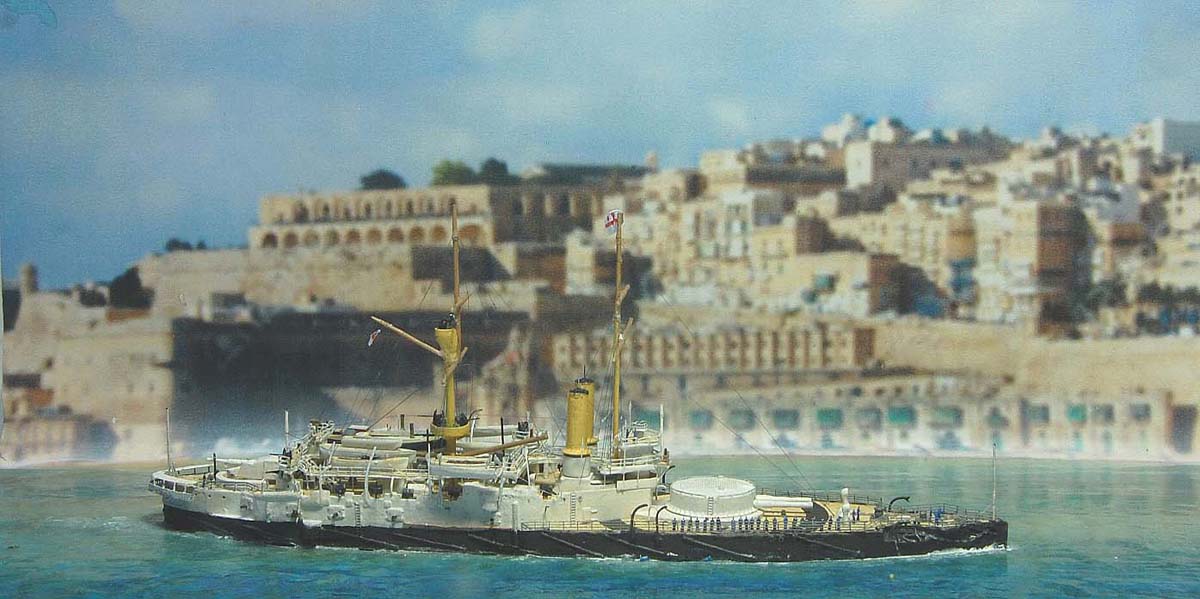
1/700 HMS Sans Pareil (Combrig)
|
by Chris Smithers |

1/700 HMS Sans Pareil (Combrig)
Here we have HMS Sans Pareil entering Grand Harbour, Malta in about 1897.
She was of course the sister ship of the ill-fated HMS Victoria sunk in a collision during fleet manoeuvres in 1893.
“It’s a battleship, Jim. But not as we know it.” Dr. Spock might also have observed that pre-dreadnoughts (and for that matter pre-pre-dreadnoughts) are pretty thin on the oceans of the world of model warships. Reasons for this could be that (a) they are quite small, (b) they are fiendishly complicated and (c) that they just look – well, weird.
If boat decks and ships’ boats are your thing, you’ll have a whale of a time with pre-pre-dreadnoughts. On this model the boat skid stowage is a cat’s cradle of beams running athwartships and fore and aft – supported by 30 odd stanchions and angled struts. Accidentally disturb one piece and the knock-on effect will generate expletives of the lower-deck variety.Without question this is the most difficult model I’ve made until now. That’s not the fault of the kit, which is superb. There are the usual issues of as-fitted drawings, photos and other modellers’ handiwork showing variations on a theme, and you have to make your own interpretation from what evidence you have available. The photo-etch is perfectly dimensioned and fits the resin hull and superstructure with total accuracy.
But there are two major problems to deal with. The first is that the parts shown on the perspective assembly drawings need to be translated to the bits you get. There are dozens of cast resin blobs to be worked out what they are.There’s a printed sheet of photographs of the resin parts, but they are not identified in any way. And none of the photo-etch parts on the fret are identified as to what they are either. By way of comparison, White Ensign and Gold Medal Models sets come with a printed sheet identifying each part. Not with Combrig. You have to try and figure out which bits are gun barrels and which are stanchions. Secondly, all the light tertiary armament is mainly photo-etch, with pivots, pillars, cradles, breeches and barrels having to be individually assembled. Which might just be achievable in 1:350 scale or larger, but in 1:700 scale even the tiniest drop of your thinnest super glues is two or three times bigger than the piece you are trying to apply it to. So I ended up scratch-building these, which was easier.
Combrig supply funnels of different lengths so the model can be made up either as the Sans Pareil or Victoria. There were other differences between the two ships (other than the Sans Pareil’s tall foremast) which aren’t provided for in the kit, although the more subtle of these have little impact on the resulting model.
No masts or yards are supplied with the kit but there are dimensioned drawings which I used to make them using soldered brass rod.The ship’s boats are exquisite – such a shame Combrig don’t make them available as separate packs for use on other manufacturers’ kits. The machinery compartment vents on the steam picket boat actually have concave hoods, hatches have tiny hinges, the decks have fairleads and there’s even a tiny PE prop shaft and propeller.
Verdict: a very challenging build involving vast amounts of rigging (which I had to simplify) as well as the issues highlighted above. Definitely not one for the faint-hearted.
